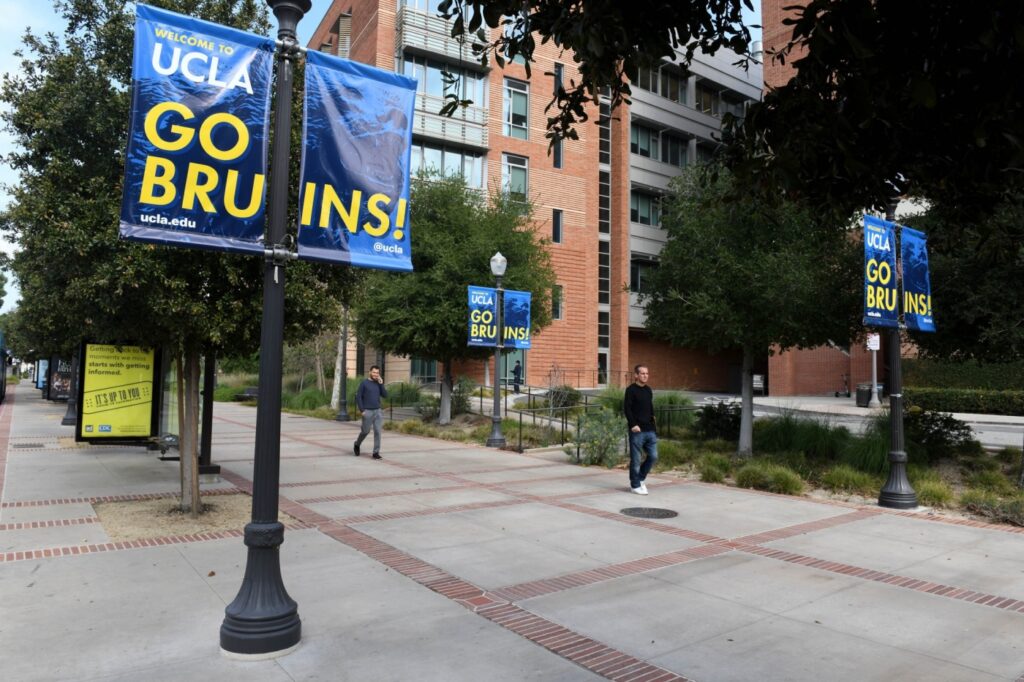
Reeling from the shock of UCLA’s announcement last month that it plans to join USC in a move to the Big Ten from the Pac-12, the University of California Board of Regents dipped its toe into the rapidly evolving world of college athletics Wednesday, looking for a way to avoid such seismic surprises in the future.
The board didn’t take any action that would block the Bruins’ departure in 2024, but after discussing an interim report on the predicted multi-million-dollar impact of the move, the regents talked through a potential policy change that could limit campuses’ ability to make major decisions involving athletics contracts without additional oversight.
Last month, the board — and Gov. Gavin Newsom, who also expressed dismay that he learned of the decision from news reports — requested the report, which they discussed in a meeting at UCLA’s Luskin Conference Center, just a few paces from where the UCLA football team practices.
Newsom wasn’t at the meeting, but regents considered putting limits on the UC president’s ability to delegate decision-making authority to campuses on certain athletics issues: If situations represent a “material adverse impact to other UC campuses”; if they “raise a significant question of university policy,” or if they create “significant risk or reputational harm to any campus or to the university.”
A vote on changing that delegation of authority could come at the regents’ September meeting.
Since 1991, the Office of the President has delegated authority to chancellors to execute certain agreements – including intercollegiate athletic agreements. But chancellors, whose priority is promoting the overall welfare of their campuses, are often not best positioned to consider the university-wide perspective because of the inherent conflicts of interest, according to the report.
So the report also proposed requiring university presidents to alert the board chair and chair of the committee with jurisdiction on major athletics decisions so they can decide whether the matter should go before the full board for discussion.
“It assures the system-wide perspective that I think people were concerned about, and looking at the potential impacts not only on specific campuses, but all the campuses across the system,” said Charles F. Robinson, UC’s general counsel. “But it also then allows some flexibility for the regents to decide in a specific case whether or not they believe that oversight is better exercised at the regents’ level.”
According to the UC’s calculations – which were based largely on reporting from a variety of news media outlets – USC’s move to the Big Ten would represent an estimated loss of about $9.8 million in annual media rights for each of the remaining Pac-12 campuses. That’s because USC is the biggest driver of football viewership revenue in the conference, representing as much as 30% of the media value.
Additionally, the report indicated that UCLA’s pending departure is expected to have “perhaps a third of USC’s impact” on the other campuses – losses that will solely affect Cal Berkeley among the UC schools because it’s the only other member of the Pac-12.
The report also offered a glance at what the conference switch will mean for UCLA’s athletes, who, as a part of the Big Ten, will be playing most of their conference road games farther away, between 1,500 and 2,700 miles from L.A.
Currently, only three of UCLA’s 25 teams – football and men’s and women’s basketball – use chartered flights to get to competitions. But eight other UCLA teams (and their 175 student-athletes) who will compete in the Big Ten now fly commercially for their two to five conference-related away trips each year.
Women’s soccer, for example, stands to spend about 15 additional hours per season traveling, said Pamela Brown, the vice president for UC’s Institutional Research and Academic Planning. She noted that at least one other team would likely see its total travel hours increase by 24 hours.
Related Articles
Former walk-on Hudson Habermehl earning a shot at TE for UCLA
Pac-12 FB ops chief won’t tolerate “shenanigans” with USC and UCLA
Modesti: The money, smart or not, is on USC football
Tight end Mike Martinez no longer with UCLA program
Lincoln Riley encouraged by USC’s back-and-forth camp
Even so, those preparing the report got positive feedback from UCLA’s student-athletes, some of whose sports might have been in jeopardy because of the athletic department’s reported $102.8 million debt.
In the Big Ten, the Bruins are expected to double their annual media rights revenue by receiving as much as $90 million annually in distributions, funding that could provide Bruins athletes with additional resources, such as, say, academic support on the road – something the athletes surveyed said they hoped for.
“In addition, being able to play against Big Ten schools could increase opportunities for tournament play and bowl games,” Brown added, passing along the feedback. “And there could be some increased visibility which could improve student athlete name, image likeness opportunities and also improve recruiting that could help student athletes play with other top players and improve the team rankings.”
